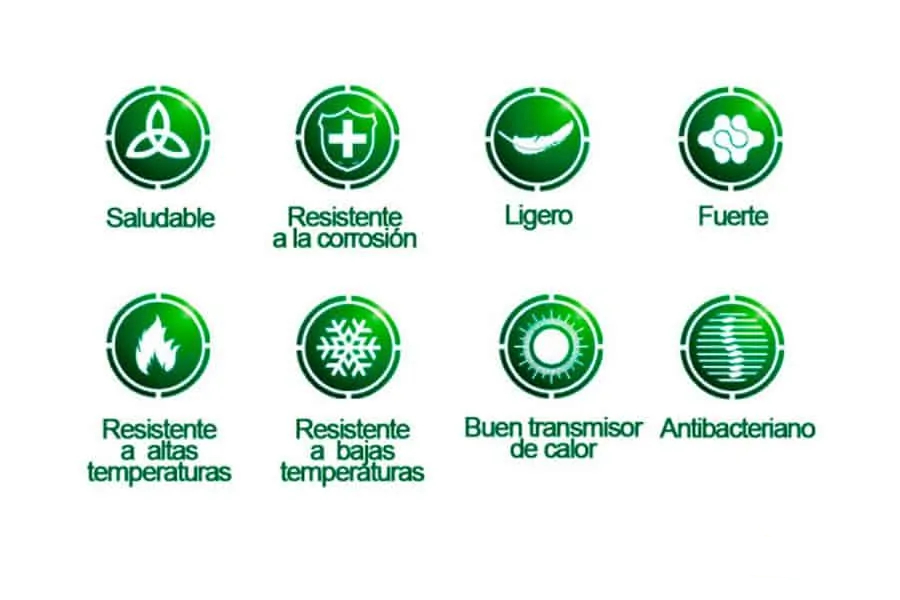It is very important to know the difference between the types of raw materials, technological products and materials before starting to see the material properties. Therefore, today we bring you within our article, all the characteristics of the materials and raw materials that you should know.

Know the properties of different types of materials.
Material properties
First of all, we have the raw material, which are substances that are obtained from direct extraction from nature, such as animal products (skins and silk), vegetables (Cotton, cork, wood), and minerals ( Sand, Clay, marble, among others).
On the other hand, we have the materials, which come to be the raw material transformed through a physical and / or chemical process, which is generally used to manufacture any product, such as the materials for a table of wood, plastic, sheet metal, clay or ceramic materials, among many others.
Likewise, these materials have certain properties that are responsible for determining whether they are suitable to be able to manufacture a technological product. When it comes to technological products, they are objects already built to meet the current needs of human beings, whether they are tables or even beams.
Main technological materials
Among the main technological materials that can be used we have ceramic materials, which are produced by molding clay and subjecting it to a high-temperature coercion process.
Then we have plastic materials, which originate from oil; vegetables such as: cellulose, natural gas and some animal protein, such as plastic rubbers, cellophane or PVC.
Likewise, we find metallic materials, which we can obtain thanks to the minerals found in the rocks; They tend to be made of iron, steel, copper, tin, aluminum, among many others. We have the wood, which comes from the woody part of the trees; Firs, pines, chestnut trees, and any species of tree that exists is usable.
Textile materials, which are obtained from raw materials such as cotton, wool or silk, and others such as nylon and lycra from plastic materials. And finally we have the materials created with stone, which are those that are extracted in different ways from rocks, from the largest to blocks, to sand, such as marble, slate, plaster or glass.
Properties of electrical materials
This type of property determines the behavior of materials when they are subjected to an electric current, one of these characteristics is known as conductivity, which is the property that materials have to be able to transmit electric current. The materials that work based on this can be:
- Conductors: Which are responsible for allowing the current to pass easily through them.
- Insulator: Those on the other hand are so called because they do not allow the easy passage of current through them.
- Semiconductors: They are known as semiconductors since they allow the passage of current in them but with certain conditions. For example, as they are conductors from a certain temperature and if it is below it, they are insulating.
Mechanical properties
When it comes to properties, we are probably facing one of the most important, since they describe the way in which materials behave at the moment they are subjected to the actions of some external force. A very general property of this type of materials is mechanical resistance, which is the resistance that materials present to some external force, among the best known we have:
- Elasticity: What is the property of bodies to be able to obtain some permanent deformation.
- Malleability: It is the one that has the ease that it has properties to be able to spread in sheets or plates.
- Ductility: It is the property that forms a material to be able to extend and thus form the wires or cables.
- Hardness: It is the resistance that a material opposes to being marked by another material. The hardest known is diamond, as only one diamond can scratch another diamond. In order to measure the hardness of a material, the Mohs scale is used, with a scale of 1 to 10.
- Tenacity: It is the resistance that a material offers to break when it is hit.
- Fragility: Being the opposite of toughness, it is the ability of bodies to break very easily when they receive a blow. Glass is a tough material, as it is brittle and hard at the same time.
Thermal properties
These are the ones in charge of determining the behavior of materials in contact with heat. Among the materials with thermal properties that we know we have the following list, in which they are:
- Thermal resistance: It is the resistance that a material has to pass through heat. In the event that a material has a lot of thermal resistance, it is a poor thermal or heat conductor, as can the properties for flame retardant materials. If a material has low resistance, it is a good conductor of heat, as are heat sinks.
- Thermal conductivity: It is the one that measures the capacity of a material to transmit heat, which means that if it is a good or bad conductor of heat. Thus, contrary to resistance, which is a material with high thermal conductivity, being a good conductor of heat, unlike what happens with thermal resistance.
- Fusibility: It is the ease with which a material can melt, so you can go from liquid to solid and vice versa.
- Weldability: It is the ability of a material to weld itself or with some other material. Clearly, materials with good fusibility tend to have good weldability.
- Dilation: It is the increase in size that a material can experience when its temperature rises.
If this information has been helpful, we invite you to see our website, where you can find a wide variety of information on technology such as Parts of the multimeter and its functions The 5 secrets! We will also leave you a video in case you want to supplement this information.
